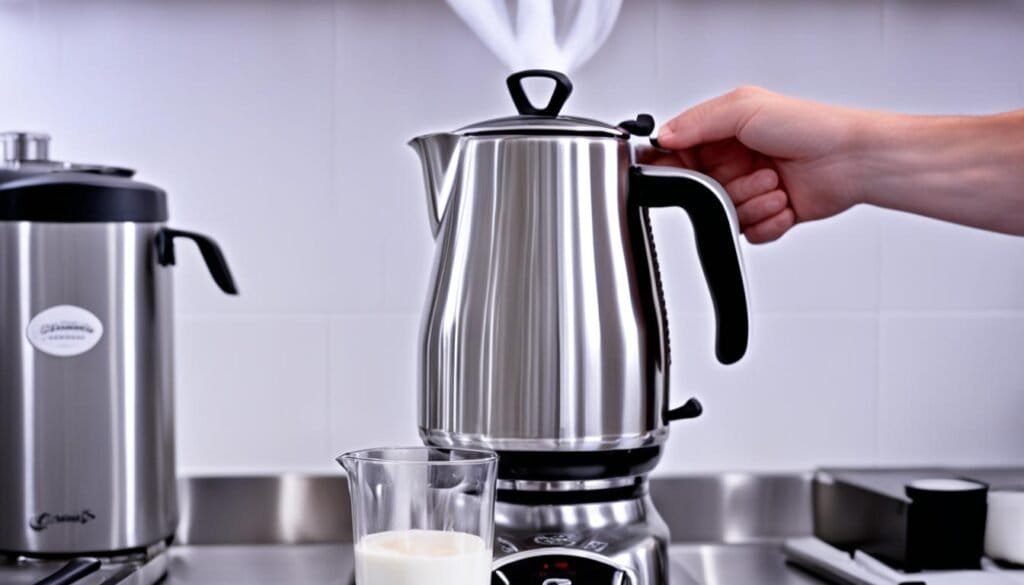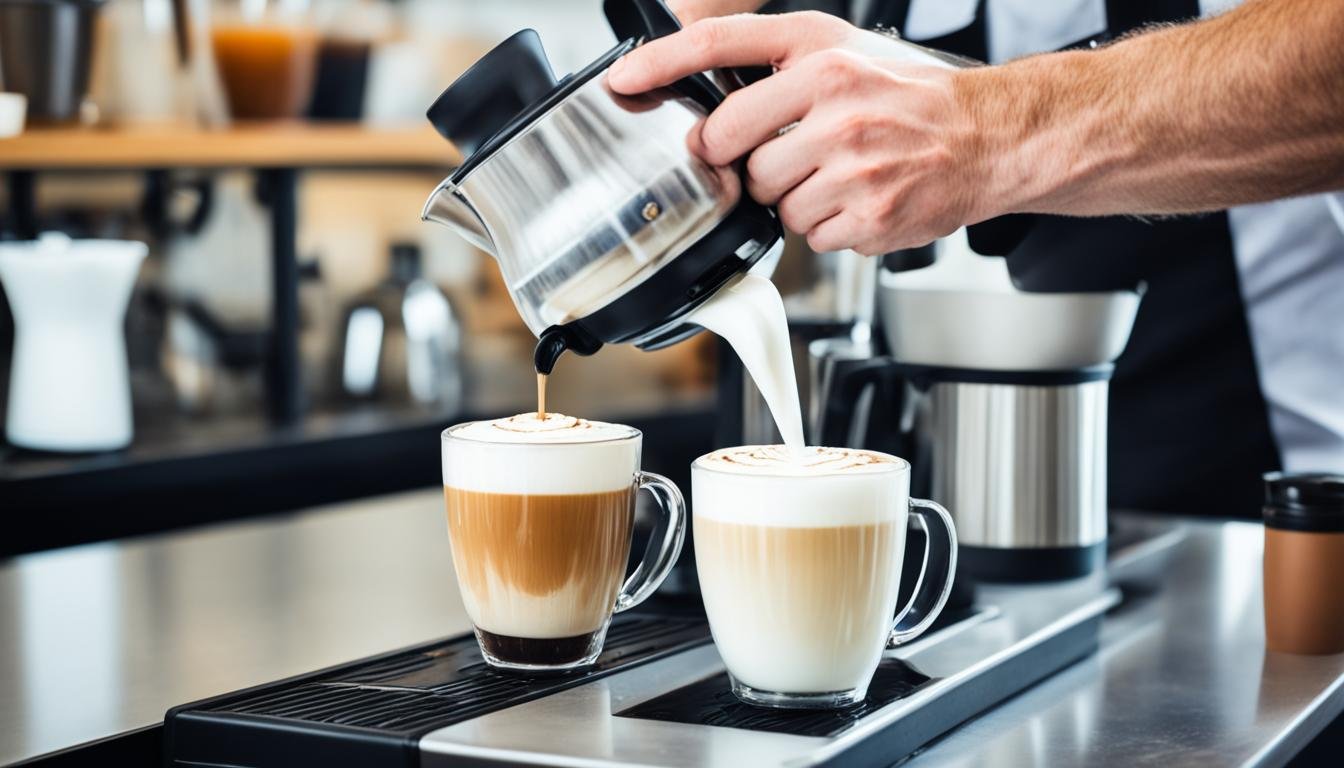Did you know that the latte is the most popular espresso-based drink in America? In fact, it accounts for a staggering 35% of all coffee orders! Whether you’re a coffee connoisseur or simply someone who enjoys a creamy and comforting beverage, mastering the art of latte making is a skill worth acquiring.
In this comprehensive beginner’s guide, we will take you on a journey to discover the top tips and tricks for creating the perfect latte at home. From understanding the key ingredients to mastering the brewing process, you’ll learn everything you need to know to brew like a pro in no time.
Key Takeaways:
- 35% of coffee orders in America are lattes.
- Mastering the art of latte making is a valuable skill.
- This beginner’s guide will provide tips and tricks to help you create the perfect latte at home.
Coffee Lovers Guide: Barista Techniques and Latte Art Tutorial
Welcome to the coffee lovers’ guide, where we will take you on a journey into the world of barista techniques and latte art. Whether you’re an aspiring home barista or simply looking to impress your loved ones with beautifully crafted latte designs, this section is for you.
Barista techniques are the key to transforming a regular latte into a masterpiece. One of the most important skills to master is the art of frothing milk. Properly frothed milk adds a velvety texture and creamy consistency to your latte, elevating the overall taste and experience. We’ll show you the step-by-step process to achieve that perfect microfoam every time.
Once you’ve mastered the basics, it’s time to explore the exciting world of latte art. With a bit of practice and patience, you can create stunning designs that will make your latte truly Instagram-worthy. From simple heart shapes to intricate rosettas, we’ll guide you through the techniques needed to bring your latte art to life.
“Latte art is like painting with coffee. It’s a unique way to showcase creativity and bring a touch of beauty to your everyday cup of joe.”
– Samuel Smith, Master Barista
To truly immerse yourself in the art of latte making, it’s essential to understand the importance of milk temperature, pouring techniques, and the role of espresso in creating the perfect canvas for latte art. We’ll explore these aspects, providing you with valuable insights and practical tips that will take your latte-making skills to new heights.
Are you ready to become a master latte artist? Let’s dive in and unlock the secrets of the barista world together.
The Perfect Latte: Ingredients and Brewing Process
In order to brew the perfect latte, it’s essential to understand the key ingredients involved and the brewing process. By mastering the art of selecting high-quality latte ingredients and following the proper steps, you can create a rich and satisfying cup of coffee that rivals your favorite café. Let’s dive into the core elements that make up a delicious latte and explore the secrets behind frothing milk and the brewing process.
The Essential Ingredients
The foundation of a great latte starts with two primary ingredients: coffee and milk. When it comes to coffee, opt for a medium to dark roast that provides a robust flavor profile. Look for freshly roasted beans for the best results. As for the milk, whole milk is the ideal choice for creating a creamy and velvety texture in your latte. However, you can also use alternative milk options, such as almond or oat milk, for a dairy-free alternative.
Now, let’s take a closer look at the proper frothing milk for latte technique to achieve that perfect creamy texture.
Frothing Milk for the Perfect Latte
Frothed milk is what gives a latte its signature creamy consistency and allows for beautiful latte art to be created. To froth the milk, you’ll need an espresso machine with a steam wand or a handheld milk frother. Here’s a step-by-step guide to froth your milk:
- Pour cold milk into a stainless steel milk pitcher, filling it about a third full. The stainless steel pitcher helps to conduct heat evenly.
- Position the steam wand just below the surface of the milk, allowing the steam to create a swirling motion.
- Slowly raise the pitcher as the milk expands, while maintaining the swirling motion. This creates small bubbles and a creamy texture.
- Froth the milk until it reaches a velvety consistency, making sure not to overheat it. The ideal temperature is around 150°F.
- Tap the pitcher on the counter to remove any large bubbles and give the milk a gentle swirl to incorporate any remaining foam.
Now that you have perfectly frothed milk, it’s time to move on to the latte brewing process. Let’s discover the steps to brewing a delicious latte.
The Latte Brewing Process
To brew a latte, you’ll need an espresso machine with a built-in milk frother or a separate milk frother. Here’s a simple breakdown of the latte brewing process:
- Start by grinding fresh coffee beans to a fine consistency suitable for espresso.
- Insert the portafilter into the espresso machine, ensuring it’s securely in place.
- Distribute the ground coffee evenly into the portafilter and tamp it down firmly using a tamper. The tamper helps create an even and compact coffee bed, allowing for optimal extraction.
- Attach the milk pitcher to the steam wand and submerge the wand into the milk, positioning it just below the surface.
- Select the espresso shot option on the machine and start the extraction process. Aim for a double shot, which is typically around 2 ounces.
- Once the espresso shot is brewed, remove the portafilter and discard the used coffee grounds.
- Activate the steam wand to froth the milk, as mentioned earlier, and ensure it reaches the desired consistency.
- Pour the frothed milk gently over the espresso shot, centering it to create latte art if desired.
- Serve and enjoy your homemade, perfectly brewed latte while it’s still hot!
By following these steps, you’ll be able to consistently brew a delicious latte with a rich flavor, velvety texture, and beautiful latte art. Now that you have mastered the ingredients and brewing process, it’s time to explore further customization options and put your creativity to the test. Experiment with different syrups, spices, or toppings to create your own unique latte creations.

| Ingredient | Amount |
|---|---|
| Coffee beans | 1-2 tablespoons |
| Cold milk | 1 cup |
Conclusion
In conclusion, this beginner’s guide has equipped you with the knowledge and skills to create a truly delicious latte at home. By following our expert tips and techniques, mastering the art of latte making, and exploring the various ways to customize your latte experience, you can enjoy cafe-quality beverages from the comfort of your own kitchen.
Elevate your morning routine by starting your day with a perfectly brewed latte that satisfies your taste buds and energizes you for the day ahead. Impress your guests with your newfound latte-making expertise and treat them to a delightful coffee experience.
Now that you have all the tools and know-how, it’s time to unleash your creativity and experiment with your latte-making skills. Add flavored syrups, sprinkle some cocoa powder, or create intricate latte art to personalize your drinks and make them truly unique. Savor the delightful taste of your homemade latte and enjoy the satisfaction that comes with crafting a beverage that rivals those from your favorite coffee shop.
FAQ
What is a latte?
A latte is a popular espresso-based beverage that consists of steamed milk and a shot (or shots) of espresso. It is often topped with a thin layer of milk foam.
How do I froth milk for a latte?
To froth milk for a latte, you will need a milk frother or a steam wand on an espresso machine. Start by pouring cold milk into a frothing pitcher and then submerge the steam wand just below the surface of the milk. Turn on the steam and let it froth the milk until it reaches your desired consistency.
Can I make a latte without an espresso machine?
Yes, you can make a latte without an espresso machine. An alternative method is to brew a strong pot of coffee and then heat and froth the milk separately using a stove or a microwave. Once both the coffee and milk are ready, combine them in a mug or a glass.
What are some common latte art designs?
Some common latte art designs include the heart, rosetta, tulip, and swan. These designs are created by pouring the steamed milk into the espresso in a specific pattern while using a technique called free pouring. With practice, you can learn to create intricate and beautiful latte art designs.
What are some popular variations of lattes?
Some popular variations of lattes include flavored lattes such as caramel latte, vanilla latte, hazelnut latte, and mocha latte. Additionally, you can experiment with different types of milk, such as almond milk or oat milk, to create dairy-free or vegan lattes.




